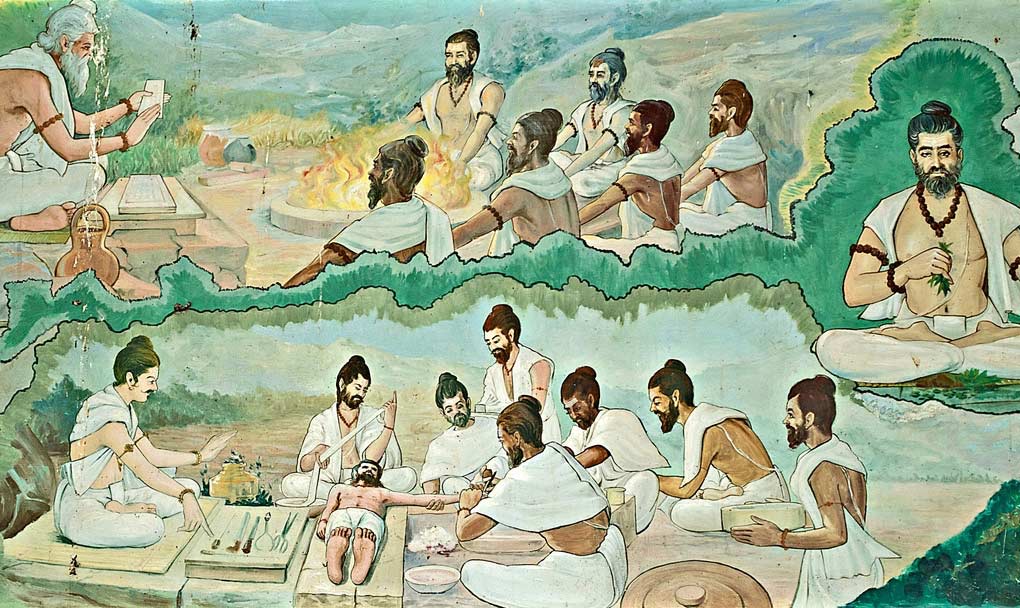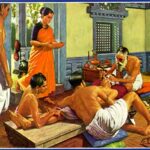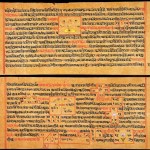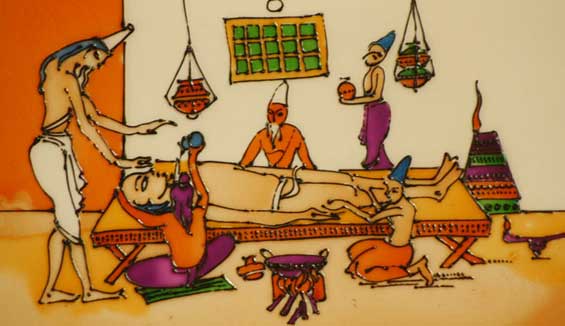
Earlier this year, we published the first in our Series on Classical Indic Medicine, better known as Ayurveda. Today we continue with our next installment, History of Ayurveda. Due to the expansive nature of the topic, it will be covered in a number of sub-parts covering Ancient, Medieval, and so on.
Introduction
History is more than just a listing of contested battlefields, but often becomes a contested battlefield of its own. On the one hand are motivated foreign accounts designed to deprecate and minimise the accomplishments of a local culture, and on the other are bombastic and argumentative parrots who make hyperbolic claims rooted less in evidence and more in atisayokti. But real history is rooted in fact and offers (or at least attempts to offer) evidence. Thus, the Charitra of Ayurveda is one that is not only a matter of national pride, but more importantly, is one of epistemological need. If you don’t know where you’re from, you don’t know where you are going. If we don’t know the true history of Ayurveda (or at least attempt to document what is in fact empirical), then it becomes difficult to shape a coherent sense of where it should go.
Before, traditionalists object, we are not suggesting striking off of inconvenient “mythological roots”. Rather, we will simply engage in a division between Legendary origins and Empirical History. This will defend the sacred while preserving the science. Charitra refers to Chronological History, which is contained within the larger subject area of Itihasa.
Itihasa means ‘So indeed it was’. “This is explained in Durgacharya’s vrtti as follows:
Iti haivamaaseedhithi yah kathyathe sa ithihaasah | 2.10 [5, 7]
Amarakoshakara states: Ithihaasah puraavrttham |
“‘that which happened in the past is itihasa’.”
In Mahabharata, definition of ‘Itihasa’ has been given in following words:
dharm-artha-kaama-mokshaanaam-upadeshasamanvitham |
purvavrttham kathaayuktham-ithihaasam prachakshathe ||
Synonyms of Itihasa: aitihya, purvavritta, paravrittanta, prachi akhyaayana, itivritta, Purana, Itismaha, Gatha, Aitihaasika Sakshya, Paramparyopadesa” [5, 7]
Dr. Deepak Yadav mentions the following as source materials for History of Ayurveda:
- Non-Historical Texts
- Historical Texts
- Travelogues
- Archaeological Material
Three Main Schools exist based on 3 upadeshtas (founders). These are as follows
Atreya School of Ayurveda:
Agnivesha, Jatukarna, Harita, Bhela, Parashara, Ksharapani
Dhanvantari School of Ayurveda:
Sushruta, Aupadhenava, Vaitarana, Paushkalavat, Aurabha, Karaveerya, Gopura Rakshita
Bhaskara School of Ayurveda:
This is mentioned in the Brahmavairavarta Purana. Prajapati taught Rishi Bhaskara, who in turn had 16 disciples.
Personalities
Ayurveda is a sacred tradition. This means that the origin of this is considered to be Divine in nature. For example the Ayurveda Prakasa begins as follows
Arthaprakaashakaasaara-vimarshambhojineemayam|
Sacchidaanandavibhavam Shivayorvapuraashrayo|| sl.1, ch.1
I bow before the united form of lord Siva & his consort, Parvati, the source of pure pleasure and which is like a lake of en-lightenment full of lotus-like deliberation.
Invariably, such books of practical knowledge begin with spiritual preliminary invocations. But modern history demands a measure of empiricism. Therefore, we have divided the historical section into Sacred Personalities and Historical Personalities, for whom historicity can be asserted. Naturally, this list begins with the Creator himself.
Sacred Personalities
Brahma
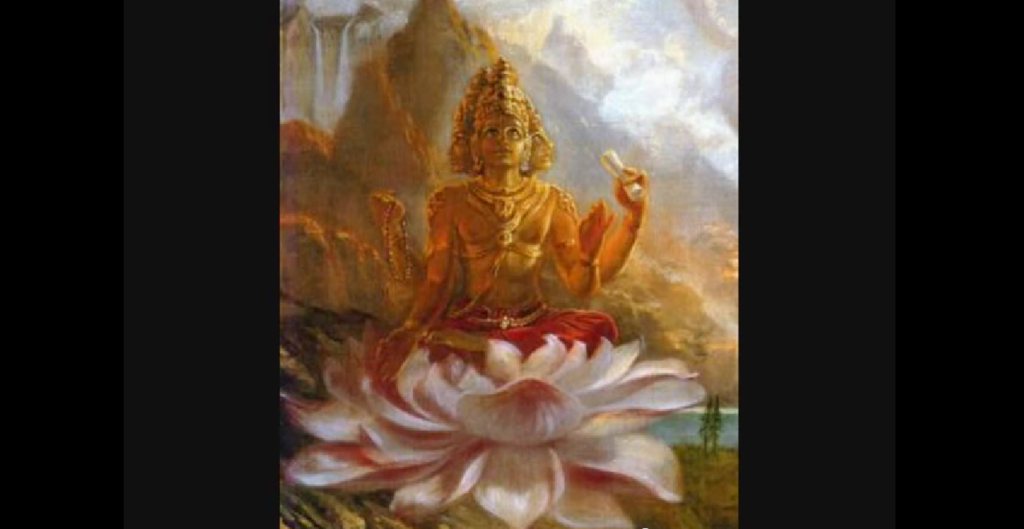
“According to Charaka (C.S. I. 1), Aayurveda emanated from the Creator, Brahma, who revealed it in its entirety to Prajapathi, ‘Lord of the Creatures’. From him it was passed on to the Ashvins, the divine twin horsemen, helpers and healers among Vedic gods. They passed it on to Indra, king of the gods, and from him mankind received its divine wisdom.” [1, i]
Ashvins
The Ashvini Kumaras are a significant element of the Vedic pantheon. These twin divinities are horsemen and surgeons of great skill. It is said that they first learned the science of Ayurveda from Brahma, and then were convinced by Indra to teach him as well.
Indra
Devendra (the King of the Gods) is considered a traditional authority on Ayurveda. Various Vedic hymns invoke him to bestow prosperity. Bharadvaja learns Ayurveda from him.
Brhaspathi
Though there is no known medical work attributed to him, Brhaspathi, as preceptor of the Devas, is also a physician of great authority.
Usaanas
Better known as Shukracharya, he is the fierce rival of Brhaspathi and preceptor of the Asuras. The well-known pauranic Episode of Kacha & Devayani discusses how Brhaspathi’s son goes to learn the secret of the life-giving Sanjeevani mantra from Shukracharya.
Kashyapa
Maharishi Kashyap has an august place in the Puranas. It is said that he is the one who drained Kashmir of a great lake, making it habitable. Thus, the land is named after him— Kashyap-mira. The great sage is the son of Maharishi Marichi and is the earliest medical authority quoted by Charaka.
According to the Charaka Samhita, Indra taught Ayurveda to Kashyapa , who then explained it to the Maharishis Vasishta, Atri, and Bhrgu.
Dhanvantari
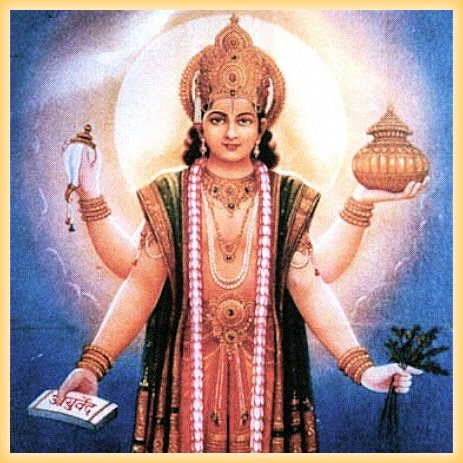
It is said that one who is learned in shalya tantra (surgery) is called Dhanvantari. Per the Sushruta Samhita, he was the god ‘who freed the other gods from senility, disease and death’. He instructed Sushruta and various sages in surgery. Some assert he did this in his incarnation as Kashiraja Divodasa.
Dhanvantari is credited with the medical work Chikitsa Tattva Vijnaana. [5, 39]
According to Dalhana, there were 6 disciples of Dhanvantari: Aupadhenava, Vaitarana, Aurabhra, Paushkalavata, Karaveerya, Gopura Rakshita. [1, xviii]
Vrddha Jivaka
A famed specialist of pediatrics, Vrddha Jivaka compiled the Kashyapa Samhita, based upon the instruction of his teacher. He is also called Kumarabhaccha as he evidently became vaidya at a young age. He is mentioned as the son of Rishi Richika, of pauranic fame. [5, 49] A number of formulations are ascribed to him, such as Saureshvara Ghrta (said to cure shilapada (elephantiasis), grahani (sprue), and shotha (edema). [5, 49]
Bharadvaja
Bharadvaja is an eminent name in the annals of Hindu lore. Most famous as Maharishi Bharadvaja, son of Brhaspathi, he is mentioned as one of the upadeshta (propounder) sages of Ayurveda.
Other Bharadvajas are also listed, such as the Shura King Bharadvaja, Kumarashira Bharadvaja, Vajineya Bharadvaja, and so on. Determining which, if any, refer to the Sage is beyond the scope of the present article. What is notable is that credit for bringing knowledge of Ayurveda to mankind is often given to Maharishi Bharadvaja. He is said to have approached Sakra (the King of the Devas, Indra) to learn this branch of study. [5, 26]
Though some attempt to assign the date of 1500-1000 BCE, it’s clear he’s a Legendary figure for whom time period assignment within the present paradigm would be counter-productive. The medical work Bharadvajiyam is attributed to him, and Bhava Mishra also mentions the great rishi’s work in materia medica and therapeutics. The Dravya Visheshaka Bheshaja Kalpa states that it contains knowledge ascribed to him.
Atreya Punarvasu
The Atreyas are a well-known lineage of Brahmanas descending from Maharishi Atri. Four Atreyas are prominent in the Indian medial tradition. These are Punarvasu, Krsnatreya, Dattatreya, and Bhikshu.
The present one is known by other names such as Chandrabhaga and Atriputra, he is best known as Punarvasu. This legendary figure’s mother was Chandrabhaga (associated with the famous river in Punjab). Incidentally, Vrddha Jivaka learned from an Atreya who was said to have been the head of the Medical Faculty at Takshasila.
Atreya Punarvasu was a student of Bharadvaja muni. He himself had 6 disciples. As previously stated, these were Agnivesha, Jatukarna, Bhela, Harita, Ksharapani, and Parasara). The king of Gandhara, Nagnajit, is also listed as a student of Punarvasu. Atriputra was a specialist in Kayachikitsa (internal medicine). Various formulations are attributed to him. These are Rajavallabha Taila, Ardhamatrika basti, Vimshati Sarasava, Dadhika, Ghrta, Maha Mayura Ghrta, and Brhad Guduchi Taila. [5 38]
Agnivesha
Acharya Bhela
A student of Punarvasu Atreya, he was also a classmate of Agnivesha. He is credited with his own medical treatises, and is cited by widely respected authorities such as Vagbhata, Dalhana, Chakrapanidatta, Shivadasa Sena, Vijaya Rakshita, and Shrikanthadatta.
“Bhela’s study of mind differed from that of Caraka and Sushruta. He pinpoints the brain as the seat of the mind; whereas Caraka and Susruta studied it connected with the heart.” [6, 135]
Parashara
Maharishi Parashara is a legendary sage and father of Veda Vyasa. He authored the Parashara Samhita, and is himself cited by Shrikanthadatta, Shivadasa Sena, and Vijaya Rakshita.
Haarita
Another famous, sage, he was one of the pupils of Punarvasu. Harita Samhita is his eponymous work. Formulations such as Katuka Ghrta, Mahavasadya Ghrta, Lashuna Ghrta and Mahanila Ghrta are all credited to him.
Ksharapani
Yet another student of Atriputra, his medical treatise, the Ksharapani Samhita has been lost. Nevertheless, he is frequently quoted in later works and commentaries. Mentions to this can be found in the commentaries of Jejjata, Chakrapani, Dalhana, Arunadatta, Vijaya Rakshita, Shrikanthadatta, and Shivadasa Sen. A number of formulas are attributed to him: Bilvadya Ghrta (for splenic disease) and Nila Ghrta (for leucoderma). [5, 46]
Chyavana
This Bhargava is famous for a medical concoction called Chyavanprash, which is said to have rejuvenated him and is still used today to instill strong immunity in consumers. It is considered the “first brand” by many marketers. Nevertheless, the formula itself is assigned to Krshnatreya, per the Haaritasamhita.
Determining at one point the mists of Legend become verifiable and definite dates is a difficult question to answer. Where dates are not possible, clear time periods are often preferable. The various lineages of Ayurveda often combine what is considered “mythology” with what is considered history. Some may prefer the removal of the traditional altogether. But as we wrote above, Ayurveda is a sacred tradition, and even if its traditional origins and sacred figures are not accepted as “historical”, the traditional account should nevertheless be preserved and passed on.
Having done so, we can now discuss various personalities who are presently considered as verifiable figures in the History of Ayurveda.
Kashiraja Divodasa
The great Vedic King Divodasa is celebrated in Vedic history as one who conducted 10 Ashvamedha yagnas simultaneously. He is also known for being a learned scholar of Ayurveda. He is said to have learned from Prajapati’s disciple Bhaskara.
The lineage of Divodasa is as follows
Kasha → Dirghatapa → Dhanva → Dhanvantari → Ketumana → Bhimratha → Divodasa → Pratardana → Vatsa → Alarka.
Some associate him with the deva Dhanvantari himself. Regardless, his father was Bhimaratha (also called Sudeva).
Bhava Prakasha explains that Dhanvantari appeared on earth in Banaras in the princely family of Bahuja and came to be known as Divodasa, that he wandered about as a vagrant even during his early years, and that Brahma influenced him to accept the crown of Banaras (Kashiraja). [5, 38]
His skill in surgery is well-known, and he is credited with Chikitsa Darpana & Chikitsa Kaumudi. Kashiraja Divodasa’s disciples were 6 in number: Sushruta, Bhoja, Nimi, Kankayana, Gargya and Galava.
It is said that Divodasa advised Sushruta to compile his Samhita on Ayurveda. [6, 79]
Maharaja Nimi
Progenitor of the Videha line of the Suryavamsa Kshatriyas, Nimi is an ancestor of King Siradhvaja, better known as Rajarishi Janaka. Nimi is one of the earliest known opthalmologists, and is considered an authority on Shalakya Tantra (Ear, Nose, Throat).
According to Dalhana, Maharaja Nimi described 76 eye disorders. The Charaka Samhita states Nimi’s belief in 7 rasas, and 5 fold classification of vata dosha. The indriyas are considered by him to be seats of the mind. His Nimi tantra has not survived the vagaries of time, but it was considered a valuable text on netra-rogas (eye disease). Citations can be found in Nibandha Samgraha and Vyakhya Kusumavali. [5, 50] Though Maharaja Nimi’s works have not survived, he is also quoted in the Madhukosha, and Bhaavaprakaasha.
Maharaja Janaka
The father of Sita was the King of Mithila, spiritually accomplished, and highly learned in his own right. Sage Suka completed his education under him, and Rishis participated in many debates held in his court. He is considered an intellectual and medical authority as well, particularly in otorhinolaryngology.
He is counted as fourth in descent from Nimi, who was immediately followed by Mithi, Videha, and Mahavideha. They are various attributed with different texts and medicines. Janaka is credited with the Vaidyaka-sandeha-bhanjini and Janakatantra.
“Some formulations for cataract (timira) are Traiphalaghrta, mahaatraiphalaghrta, Triphala and Choornanjnana of Nimi, Prasaaranitaila of Janaka and Kunkumaadiaataila of Videha“. [6, 55]
Varyovida
An early medical authority who is also quoted by Charaka. Varyovida is called Rajarishi, and thus, appears to originated from a royal family. [5, 42]
He refuted Saraloma’s perspective regarding the cause of disease, saying “that the base of diseases is not the mind but the body. He opines that rasaas cause disease; indirectly water is the basic cause.” [6, 59]
Kankaayana
“Caraka describes Kaakaayana as the ancient and greatest physician of Baalhika. Kaankaayana is seen discussing the details of rasaas and their number with Nimi and other sages. According to him tastes are innumerable to be explained only in terms of their location, number, and function.” [6, 58] However, Kumaarasira Bhardvaja opposes this view, crediting the Divine with all roots of health.
A student of Kashiraja Divodasa, Kankaayana is also mentioned in the Atharvaparisista along with others. There are 4 formulations that are said to have been developed by him. [6, 58]
Charaka

Charaka is considered the most foundational author on Traditional Hindu Medicine, and yet not much is known about him. There are some who argue that there were a number of Charakas, and that they were “wandering physicians” as indicated by the name. One is dated to 1000-800 BCE and another to 300 BCE.
Charaka also sits at the intersection of many aspects of Dharma and Kama. Early marriage in ancient society is often critiqued, but the particular stages involved are often glossed over (or conveniently forgotten by those who practice it…). “According to Caraka, the period for sexual activity is from sixteen to seventy years of age. Twelve is the marriageable age for girls and twenty-one for boys; reproductive age is after sixteen for females and twenty-five for males. Unapproachable women and amorous seasons are described in detail.” [6, 159] This is an interesting point as it gives a clear insight into the sexual ethics of Ancient India. Many have often commented on the early marriage or even child marriage that was often practiced, but they have ignored the distinction between early marriage age and reproductive age.
Sushruta
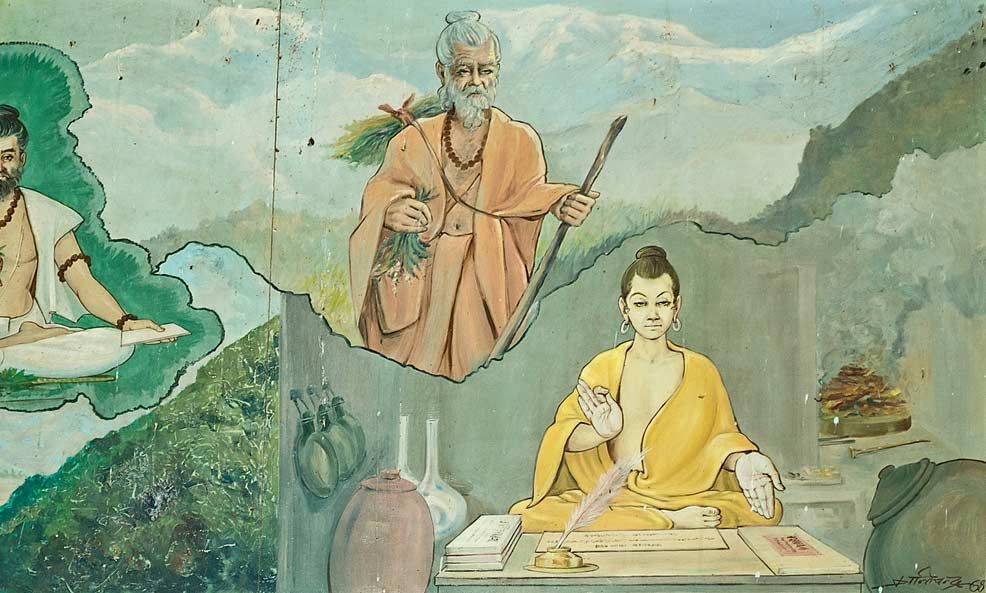
“What Caraka did for medicine, Susruta did for surgery.” [2,116] Considered by most to be the son of Maharishi Vishvamitra (though some say his veterinary medicine teacher Salihotra was), Sushruta is often called ‘The Father of Surgery’. The Sushruta Samhita records that Brahma gave Ayurveda to Prajapati, who gave it to the Ashvins, who gave it to Indra, who gave it to Dhanvantari. Dhanvantari (inclusive of his incarnation as Divodasa) had 12 disciples, who are as follows: Aupadhenava, Paushkalavata, Kankayana, Vaitarana, Karaveerya, Bhoja, Gargya, Aurabhra, Gopura Rakshita, Nimi, Galava, and Sushruta. The association with Dhanvantari himself demonstrates the antiquity of Vrddha Sushruta. Though presently dated to 1000 BCE, it is more likely based on this association that he hails from the ancient-most days of the Aryavarta. [7, 40]
By some accounts there are said to be 2 Sushrutas, of which the main is Vrddha (old). Sushruta hails from the Dhanvantari school. His Samhita contains 6 sthanas (sections), 186 chapters, and 8300 Sutras. There were numerous commentaries on this treatise, with Jejjata’s now lost work as the earliest. Others were the Brihat Panjika of Gayadasa, Bhanumati of Chakrapanidatta, Sushrutartha Sandipana of Haranachandra, Tippana of Brahmadeva, and Nibandha Samgraha of Dalhana from Kashmir.
Karaveerya
Karaveerya was a disciple of Maharaja Divodasa. He is mentioned alongside Sushruta. The work Karaveerya Tantra is attributed to him
Paushakalavata
Another disciple of Kashiraja Divodasa, he is credited with the work Paushakalavata Tantra. The name suggests he originated from or is associated with the ancient city of Pushkalavati, on the western banks of the Indus River.
Nakula & Sahadeva
The illustrious Pandavas are known throughout Bharatavarsha for their exploits in the Mahabharata. However, few knew that they were experts in medicine as well. Considered incarnations of the Ashvini kumaras, it is only natural for them to have a propensity for Ayurveda. Vaidyaka-saarasattva of Nakula and Vyaadhi-sindhu-vimarddana of Sahadeva are medical texts attributed to them. Ashvachikitsa on Salihotra (veterinary medicine) is also credited to Nakula—which is unsurprising given his reputation as an equestrian.
Vararuchi
Drdhabala (Punjab)
Conservatively dated to the 4th century CE, Drdhabala’s father Kapilabala hailed from Panchanadapura (thereby associating him with the Punjab). A devotee of Lord Shiva, he redacted the Charaka Samhita and also provided sections which had been lost. He claims to have contributed the last 31 chapters (including 17 chapters on Chikitsa Sthaana, and all of Kalpa and Sidhi Sthana). [5,52]
In effect, Drdhabala is credited with reorganising the entire Charaka Samhita.
Vagbhata
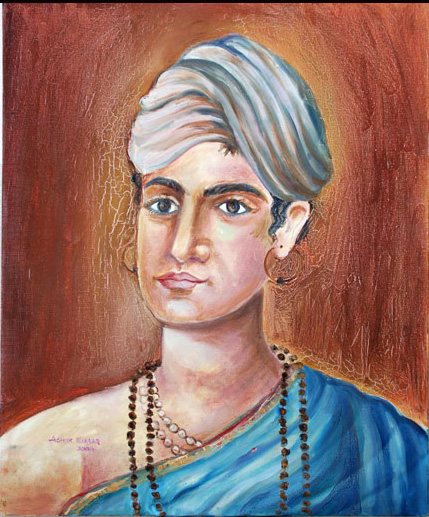
Though often not getting his due, Vagbhata I, better known is Vrddha Vagbhata, is part of the Vrddha-trayi (Charaka, Sushruta, Vagbhata). If Charaka is known for therapeutics and Sushruta known for Surgery, then Vagbhata is considered the principal preceptor of Sutra (General Principles of Medicine). [1, xxxv] The Ashtanga-sangaraha is attributed to him, and is presently dated to 550 CE. However, some assert that Charaka was his instructor. This would push his date back to at least 600 BCE, if not earlier, to be contemporanous with his teacher.
According to Dr. Yadav, there were possibly 3 Vaghbhatas: Vrddha Vagbhata (author of Ashtanga Samgraha & Ashtanga Hrdaya), Madhya Vagbhata (commentator on Chakradatta), and Rasa Vagbhata (author of Rasaratna Samucchaya). This assertion of multiplicity must be reconciled with tradition.
Per traditional accounts, Vrddha Vagbhata hailed from Sindh (i.e. Ancient Sindhu Desa). [5] In the Ashtanga Samgraha he states the following:
“There was a great physician by name Vagbhata whow as my grand-father, I bear his name; his son was Simhagupta and I am from him (Simhagupta) born int he country of the Sindhu (river Indus and its tributaries) Having learnt from Avalokita, the preceptor and even more from the wisdom of my father and after a study of a large number of texts of medical science, this text has been composed, with all branches of Ayurveda, suitably classified into sections, chapters, etc.” [5, 55]
Nagarjuna
Nagarjuna is an enigmatic figure. There are a number of Nagarjunas throughout history. Though the present paradigm considers him an Andhra Brahmin, who was a friend of the Satavahana Emperor Yagnasri, Nagarjuna is mentioned by Kalhana as having been a Kshatriya (and may not be an Andhra). A redactor of Sushruta Samhita, he was a disciple of Sarahapa and was cited by Alberuni.
Nagarjuna redacted the Suhruta Samhita and is said to have authored the Uttara Tantra. [5, 53]
Vatsya
Vatsya is the medical authority who recoved the Kashyapa Samhita from the ravages of time. He is said to have been a descendant of Bhrgu as well as the author Vrddha Jivaka himself. Vatsya provided the Pratisamskaran (redaction) for this Vrddha Jivakiya Tantra. [5, 53]
Madhavakara
Damodara
Govindadas Sen
Acharya Tisata (Kashmir)
Basavaraja (Andhra)
Madhava Upadhyaya (Saurashtra)
Sodhala (Gujarat)
Vangasena (Bengal)
Important Texts
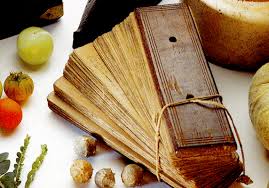
Historicity is a difficult thing to assign, particularly in the present time of science and scientism. Nevertheless, an effort must made to corroborate and collate traditional datings and traditional texts.
Chikitsa Sara Tantra of The Ashvins
Dhanvantari Nighanthu & Chikitsa Tattva Vijnana of Dhanvantari
Sarvasara of Budha
Naadi Vijnana of Kanaada
Jnanarnava of Yama
Dvaidha Nirnaya of Agastya
Jeevadaana of Chyavana
Tantrasara Sarvadhara of Jabala Kavatha
Nidhana of Paila
Samhita period. The following are the various Samhitas that are said to have contemporaneously been composed. These are: Sushruta Samhita, Charaka Samhita, Bhela Samhita, Harita Samhita, Kashyapa Samhita, and Nimi Tantra. [5, 19]
Parasara Samhita
Ksharapani Samhita
Karaveerya Tantra
Paushkalavata Tantra
Aurabhra Tantra
Aupadhenava Tantra
Chikitsa Darpana & Chikitsa Kaumudi of Kashiraja Divodasa
Videha Tantra
Vaidya Sandeha Bhanjana of Janaka
Gopurarakshita Tantra
Vaitarana Tantra
Sushruta Samhita
“Sushruta Samhita gives equal importance to theory and practice” [6, 110]
Though fundamental aspects of medicine are covered, it is primarily a work on Shalya tantra, which is Surgery. This is covered in 3 phases: purvakarma (pre-operative treatment), pradhaanakarma (treatment), and paschaatkarma (post-operative treatment).Commentators and redactors of the Sushruta Samhita include Nagarjuna and Chandrata. It is said that the original Sushruta Samhita composed by the eponymous author consisted fo 5 sthaanas and only 120 adhyaayas. These dealt primarily with surgery (shalya), with the Uttara sthaana (last sthaana) dealing with the remaining branches 6 branch Ayurveda (Shalakya Tantra, Kumara Tantra, Kayatantra, Bhuta Tantra, Rasayana, and Vajikarana). Toxicology (Agada Tantra) is mentioned in the kalpa sthaana.
- Sutrasthana is conducted in 46 chapters, covering general principles & medical education.
- Nidanasthana is covered in 16 chapters, and deals with pathology, etiology, & symptoms.
- Sharirasthana is reviewed in 10 chapters, and explains anatomy and physiology.
- Chikitsasthana is studied in 40 chapters, discusses therapeutics & preventative medicine.
- Kalpasthana is overviewed in 8. It studies toxicology and provides antivenoms.
- Uttarasthana adds 66 chapters, and discusses minor surgery, pediatrics, therapeutics, and mental illness. There is also a supplementary discussion explaining 6 tastes (shadruchi), principles of hygiene/cleanliness, medical terminology, etc. [5, 23]
Notable Facts
- 6 Sthaanas (sections), 186 Adhyaayas (chapters), and 8300 Sutras
- Provides framework of surgery as focal point
- Uses and faults of surgical instruments (101 in number)
- Instructions regarding Operative procedures such agnikarma (cauterisation)
- Disease classification and Medical Vocabulary
- Deals with medical education and stresses cleanliness.
- Tridosha System
- Classification of Drugs and curative methods
- First Principles. Vital points (marmas), along with Rasayana
- Translated into Arabic as Kitab-Shah-Shun-al-Hindi & Kitab-i-Susrud.
Commentators
Dalhana from Kashmir states that Nagarjuna supplemented it, and Chandrata (son of Tisata) conducted an emendation based on the commentary of Jejjata. [5, 21] Other commentaries (teekas) were conducted by Gayadasa (Brhat Panjika), Chakrapanidatta (Bhanumati/Tatparyateeka), Dalhana (Nibandha Samgraha), Haranachandra (Sushrutartha Sandipana), Brahmadeva (Tippana). [5, 23-24]
Charaka Samhita
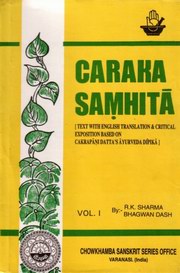 Authorship of the Charaka Samhita is ascribed to Agnivesha. This is because he was the teacher of Charaka. The latter is therefore considered a redactor and compiler, with the treatise being treated as the sum-total of his studies. Samuraka (completion) is attributed to Drdhabala.
Authorship of the Charaka Samhita is ascribed to Agnivesha. This is because he was the teacher of Charaka. The latter is therefore considered a redactor and compiler, with the treatise being treated as the sum-total of his studies. Samuraka (completion) is attributed to Drdhabala.
There are 8 sthaanas (sections), 120 adhyaayas (chapters), & 9295 sutras. 30 Chapters are on Sutrasthana, 8 on Nidanasthana, 8 on Vimanasthana, 8 on Sharirasthana, 12 on Indriyasthana, 30 on Chikitsasthana, 12 on Kalpasthana, and 12 on Siddhisthana.
These chapters & topics are organised into parts called Chatushkas, which are as follows:
- Bheshaja Chatushka encapsulates the general overview of health and medicine
- Svastha Chautshka explicates preventative and general medicine
- Nirdesha Chatushka covers effective treatment as well as the trivarga
- Kalpana Chatushka discusses treatment
- Roga Chatushka covers various conditions and illnesses
- Yojana Chatushka treats with human classification and corresponding ailments
- Annapana Chatushka analysis a wide range of topics, especially diet
- Samgaraha Chatushka
“The Caraka Samhita was the most elaborate treatise on medicine. It had eight divisions, each of them further divided into several chapters. It deal with fetal generation and development, human anatomy, and the bodily functions depending on the three bodily humours known at that time—vayu (breath or wind), pitta (gall), and kapha (phlegm). The treatise discussed the basis of the tridosa (or three-humors) theory. The work listed about fifty groups of medicines working on the various systems.” [2,115] It was a compilation of Agnivesa’s work that resulted in the composition known as Charaka Samahita. This contains 8 sthanas, 120 chapters, and 9295 sutras.
Notable Facts
- This work was translated into Persian then Arabic. It is found in Latin translations of Avicenna as Sharaka Indanus.
Commentators
Bhattaraharichandra (Charaka Nyasa), Svamikumar (Charaka Panjika), Jejjata (Nirantarapadavyakhya), Chakrapanidatta (Charaka Tatparya Teeka/Ayurveda Deepika), Shivadasa Sen (Charaka Tattva Pradeepika), Gangadhara Rai (Jalpakalpataru), Yogindranath Sen (Charakopaskara), Jyotishchandra Saraswati (Charaka Pradeepika). [5, 27]
Kashyapa Samhita
Also called the Vrddha Jivakiya Tantra, the Kashyapa Samhita is the credited to Vrdda Jivaka and is based upon the instruction of its propounder, Maharishi Kashyapa. The author Jivaka was the son of Sage Richika. Per the legend of his life, Jivaka compiled it as an adolescent, thereby causing various Acharyas to consider it invalid. However, due to some miracle, Jivaka was transformed into an old man, thereby giving him the ephithet Vrddha.
Though the work was lost in the course of time, a descendant of Jivaka named Vatsya was able to recover it (according to legend, due to Anayasa (a spirit)). Nevertheless, this Vatsya added the Khila Sthaana (supplementary section) to the 8 original divisions of the treatise.
Sutrasthana 30 Chapters, Nidanasthana 8 Chapters, Vimanasthana 8 Chapters, Sharirasthana 8 Chapters, Indriyasthana 12 Chapters, Chikitsasthana 30 Chapters, Siddhisthana 12 Chapters, Kalpasthana 12 Chapters, Khilasthana 80 Chapters.
Notable Facts
- The Kashyapa Samhita is arranged in 200 Chapters as follows [5, 33]
- Considers Kaumarabhrtya (Pediatrics) the best of all Ayurveda Divisions
- Suggests fruits to children at 6 mos, and cereals at 12 mos
- Lakshanadhyaya is a chapter purely dedicated to critical clinical symptoms
- Vedhanadhyaya is a chapter describing how expression & interpretation of child pain
- Phakka (rickets) is described. A 3 stage treatment cycle is prescribed.
- Katu taila (medicated oil) is suggested for spleen diseases
- Amlapitta (hyperacidity) is crescribed in Khilasthana
Bhela Samhita
Authored by Acharya Bhela, the eponymous Samhita is a work conducted by a colleague of Acharya Agnivesha, and structured in a manner similar to the Charaka Samhita. Unfortunately, a complete manuscript does not exist. A partial version can be found in Thanjavur, Tamil Nadu.
Notable Facts
- A work outlined in 8 Sections and 120 Chapters
- 5 types of Pitta re described
- The mind is stated as lodged in the brain
- Amalaki, Haritaki, and Bibhitaki are advised as digestives after meals.
- States there are 363 bones in the body (including body parts such as nails, etc)
- Janamara is used to refer to the word for epidemic (Janapododhwansa).
- A disease named Vatalika is mentioned. Symptoms include fever & body rash
- Apasmara, epilepsy, is mentioned
- Kayachikitsaka, Internists (Internal Medicine Specialists), are described
- 18 types of skin ailments are listed. 9 considered curable, 9 incurable.
Harita Samhita
Among the 6 disciples of Atreya was Sage Harita. He is cited by numerous commentators in succeeding millennia. Unlike Bhela, his treatise is popular and widely accepted. It should be said that there have been doubts expressed about the present manuscript available, and the author referred to as Pseudo-Harita. This allegation remains to be verified. [5, 31]
Notable Facts
- A work of 7 Sections in 103 Chapters
- Basti vikara (bladder disease) and basti karma (enema) are mentioned
- Among the 6 tastes (shadruchi/shadrasa), Kshara takes the place of Lavanam
- Harita discusses different qualities of cow’s milk
- The four types of Shaaka (leafy vegetables) are described as patra, pushpa, phala, & kanda
- There are 10 types of colic (shula vyadhi) and consumption (kshaya)
- Tridosha Kasa (cough originating from vitiation of all 3 doshas) is discussed
Ashtanga Samgraha of Vagbhata
A work on Ayurveda composed in 6 sections and 150 chapters. It is attributed to Vrddha Vagbhata. Dissection of cadavers for surgical practice is mentioned.
155 medicines are stated in Agrya prakarana. He states that the best hingula (asafoetida) is produced in Boshkana (Kabul).
Ashtanga Hrdaya of Vagbhatta
A work on Ayurveda composed in 6 sections and 120 chapters. Some attribute it to Laghu Vagbhata. Marmas are discussed in greater detail than in Sushruta Samhita. 6 categories are mentioned, along with 33 drug groups. Under shalakya tantra (otorhinolaryngology), 231 diseases are listed.
Vaidyaka Sarvasva of Nakula
Ashvachikitsa on Salhotra (veterinary medicine) also by Nakula
Vyaadhisindhu Vimardana of Sahadeva
Navaneetaka
Dating of the Navaneetaka is a somewhat problematic endeavour. Though at present dated to between the 2nd and 3rd centuries CE, it is likely more ancient than that. Worst of all, is that the author of the text is not known. The colophon and the final chapter of this treatise are missing. Nevertheless, it is useful for providing insight into the antiquity of the medical literature that came before it.
It is an almagamation of the vairous preceding kalpas and tantra, with special focus on Charaka, Sushruta, and Bhela.
Brihat Panjika of Gayadasa
Bhanumati of Chakrapanidatta
Sushrutartha Sandipana of Haranachandra
Tippana of Brahmadeva
Nibandha Samgraha of Dalhana
Andhra Tika of Ramanujacharya
Ayurveda Rasayana of Hemadri
Raja Nighantu of Narahari Pandit (Kashmir)
Raja Marthanda of Bhoja
Veerasimhavalokana of Raja Veerasimha (Gwalior)
Rasendra Choodamani of Somadeva (Bhairavapur, Uttar Pradesh)
Kalyanakaraka of Ugradityacharya (Andhra)
Bhava Prakasha of Bhava Mishra (Bihar)
Gunaratnamala
Ayurveda Prakasa of Madhava Upadhyaya
Conclusion

“When moral perfection and saintliness, as they prevailed in the ideal beginnings of time, began to decrease in the course of ages, disease made its appearance; thus the span of life was shortened and the fulfilment of religious duties hindered, along with that of vows, austerities and the pursuit of enlightened sanctity. Then, out of compassion for all beings, holy seers gathered on an auspicious slope of the Himalayas on the problem; ” By what means can disease be checked, since freedom from disease is the elementary requirement for all spiritual, secular, and religious pursuits?” [i-ii]
The answer, of course, was Ayurveda. But in our time of Science and Scientism, it is difficult for most modern folk to accept such legends. But at the same time, as the present time has shown, materialism and promiscuity have led to an epidemic of diseases. Whether or not this in fact was the origin of all disease is beside the point. As the world of consumption driven economics has demonstrated, overconsumption leads to unhealthy lifestyles and myriad health problems. The connection between lifestyle and health can no longer be ignored, and diet is at the heart of Ayurveda.
Therefore, whether one chooses to accept Sacred History or not, as we have demonstrated in the first part of this Set of Articles, there is plenty of valid Empirical History in the Annals of Ayurveda. Beyond the shroud of legend, is the very well-documented Chronology of Classical Indic Medicine. If Ayurveda, golden milk, turmeric, and basil have all become popular aspects of Western Health trends, it’s because there’s a science of well-being behind it and a proven history of ancient application. Divodasa, Sushruta, Charaka were all historical personalities to which even the most atheist of scholars could not be allergic. Agreeing upon common dates may be difficult, but the general order of these intellectual luminaries is built into the orthodox Dharmic Tradition.
It is also necessary to establish a basis for origin and a semblance of chronology due to the desire for some sections to digest the tradition of Ayurveda, as noted here. This has also infected historical research itself and dampens the credibility of foreign views of India:
“Greece is the creator of European culture. Proud of this great heritage, the west could not accept the idea that India had an older civilization, much greater. They were anxious to uphold the antiquity and grandeur of the Greek civilization and prove that India had borrowed them from the Greeks [a prejudice found in fields ranging from Maths to Drama).
“On the Contrary, there is a possibility that Greece borrowed many medicinal herbs from India. But there is no Greek influence on ancient Indian medical science.” [6, 84]
But above all, by going back into the earliest reaches of Ayurvedic Itihaas, physicians and medical practicioners of all stripes can again get back to the basics that made medicine such a noble profession in the first place. In this era of profit-driven industry and private insurance decided treatment, the Purvacharyas of Ayurveda can again illuminate why so many people across the world respected physicians in the first place:
Charaka also tells us that the medical practitioner strives to do his work not with selfish motives or for worldly-pleasures but for the relief of suffering
naatmaartham naapi kaamaartham
atha bhoota-dayaam prati [1]
References:
- Kutumbiah, Dr. P. Ancient Indian Medicine. Hyderabad: Orient Longman.1999
- Sardesai, D.R. India: The Definitive History. Westview. Boulder, Colorado 2008
- Madhulika, Dr & Ed. Jayaram Yadav. Paka Darpana. Varanasi: Chaukhambha Orientalia. 2013
- Acharya Balakrishna. Ayurved: Its Principles and Its Philosophies. New Delhi: Diamond Pocket Books. 2006
- Yadav, Dr. Deepak “Premchand”. History of Ayurveda. Varanasi: Chaukhamba Subharati Prakashan.2013
- Varier, N.V.Krishnankutty.History of Ayurveda.Kottakal,Kerala: Arya Vaidya Sala.2016
- Sharma, Krishna (Ayurvedacharya). The System of Ayurveda. Khemraj Shrikrishnadass. Bombay: Shri Venkateshwar Steam Press. 1995
- Basham, A.L. The Wonder that was India. Delhi: Rupa & Co. 1999
- Rao, S.K. Ramachandra. Encyclopaedia of Indian Medicine (Volume One): Historical Perspective. Mumbai: Popular Prakashan. 2005
- Bagul, R.M. (Dr.). Status Report on Wild Medicinal Plants of Satpuda Forest East, Maharashtra, India. Solapur: Laxmi Book Publication. 2016. P.36
